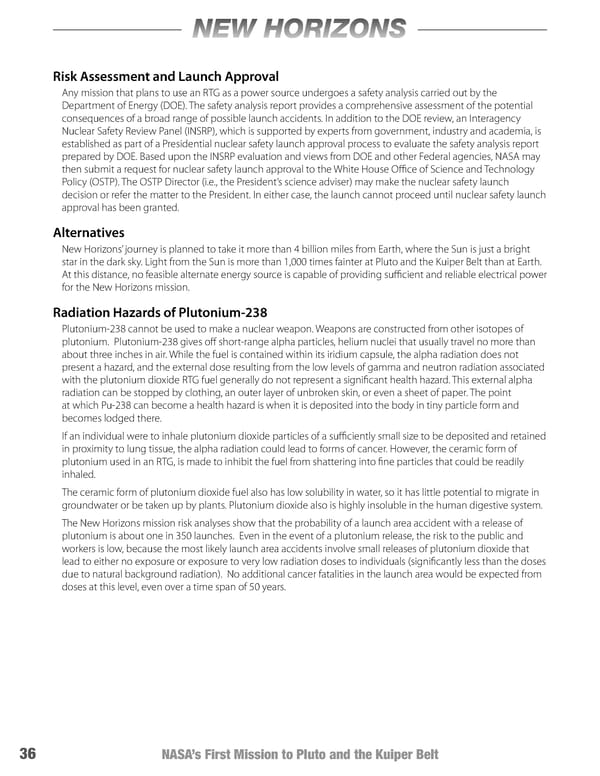NEW HORIZONS Risk Assessment and Launch Approval Any mission that plans to use an RTG as a power source undergoes a safety analysis carried out by the Department of Energy (DOE). The safety analysis report provides a comprehensive assessment of the potential consequences of a broad range of possible launch accidents. In addition to the DOE review, an Interagency Nuclear Safety Review Panel (INSRP), which is supported by experts from government, industry and academia, is established as part of a Presidential nuclear safety launch approval process to evaluate the safety analysis report prepared by DOE. Based upon the INSRP evaluation and views from DOE and other Federal agencies, NASA may then submit a request for nuclear safety launch approval to the White House Office of Science and Technology Policy (OSTP). The OSTP Director (i.e., the President’s science adviser) may make the nuclear safety launch decision or refer the matter to the President. In either case, the launch cannot proceed until nuclear safety launch approval has been granted. Alternatives New Horizons’ journey is planned to take it more than 4 billion miles from Earth, where the Sun is just a bright star in the dark sky. Light from the Sun is more than 1,000 times fainter at Pluto and the Kuiper Belt than at Earth. At this distance, no feasible alternate energy source is capable of providing sufficient and reliable electrical power for the New Horizons mission. Radiation Hazards of Plutonium-238 Plutonium-238 cannot be used to make a nuclear weapon. Weapons are constructed from other isotopes of plutonium. Plutonium-238 gives off short-range alpha particles, helium nuclei that usually travel no more than about three inches in air. While the fuel is contained within its iridium capsule, the alpha radiation does not present a hazard, and the external dose resulting from the low levels of gamma and neutron radiation associated with the plutonium dioxide RTG fuel generally do not represent a significant health hazard. This external alpha radiation can be stopped by clothing, an outer layer of unbroken skin, or even a sheet of paper. The point at which Pu-238 can become a health hazard is when it is deposited into the body in tiny particle form and becomes lodged there. If an individual were to inhale plutonium dioxide particles of a sufficiently small size to be deposited and retained in proximity to lung tissue, the alpha radiation could lead to forms of cancer. However, the ceramic form of plutonium used in an RTG, is made to inhibit the fuel from shattering into fine particles that could be readily inhaled. The ceramic form of plutonium dioxide fuel also has low solubility in water, so it has little potential to migrate in groundwater or be taken up by plants. Plutonium dioxide also is highly insoluble in the human digestive system. The New Horizons mission risk analyses show that the probability of a launch area accident with a release of plutonium is about one in 350 launches. Even in the event of a plutonium release, the risk to the public and workers is low, because the most likely launch area accidents involve small releases of plutonium dioxide that lead to either no exposure or exposure to very low radiation doses to individuals (significantly less than the doses due to natural background radiation). No additional cancer fatalities in the launch area would be expected from doses at this level, even over a time span of 50 years. 36 NASA’s First Mission to Pluto and the Kuiper Belt
 New Horizons Page 47 Page 49
New Horizons Page 47 Page 49